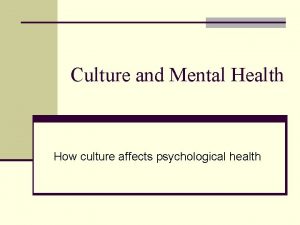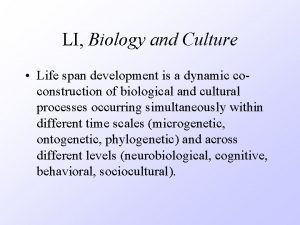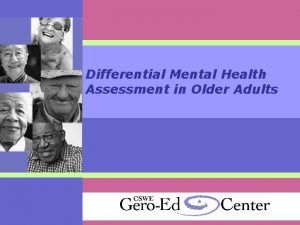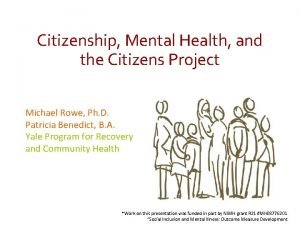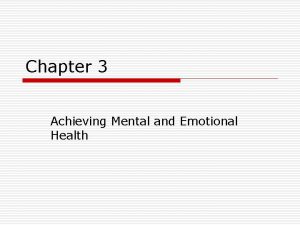Culture and Mental Health How culture affects psychological
















- Slides: 16

Culture and Mental Health How culture affects psychological health

Cultural Influences on Mental Health 1. Should we focus on race, ethnicity, and culture in therapy? 2. Cross-cultural research a. Two causal models of cultural influence b. A research example: Jamaica vs. U. S. 3. Implications for clinical intervention

Should we focus on race, ethnicity, and culture in therapy? Three good reasons not to: 1. We are all fundamentally the same 2. Each of us is a unique person with unique life experiences 3. Race/ethnicity/culture is only one type of group difference. Why focus on this particular difference and not on gender, class, and/or sexual orientation?

The role of culture n Zeitgeist n n n Drapetomania (out) Homosexuality (out) Pathological gambling (in) n Cultural relativity (emic vs etic) n Cultural influences on prevalence

Cross-Cultural Research Methodology Etic perspective • Emphasis on universals among human beings by using examination and comparison of many cultures from a position outside those cultures. • The usual etic imposed is white, middle-class, Anglo-American. • The original norms on the original MMPI (1972) described a 35 -year-old white, married, semi-skilled man with an 8 th-grade education Emic Perspective Examines behavior from within a culture, using culture-specific criteria

Causal Models of Cultural Influence (Weisz, 1987) Problem Suppression-Facilitation Model • Culture suppresses (via punishment) some behaviors • Culture facilitates (via modeling, reinforcement) other behaviors Adult-Distress-Threshold Model • Culture determines adult thresholds for different types of child problems

A research example: Jamaica vs. U. S. Jamaican Society: • Descendants from British-owned slaves from West Africa (became fully independent state in 1962). • Cultural customs reflect a combination of • British values (e. g. , respect for authority) • African values (e. g. , respect for elders) • Child-rearing often done by extended family • Non-related adults have “permission” to address a child’s behavior U. S. Society: • •

Two types of childhood disorders n Externalizing disorders: problems in conforming to expected norms; often cause problems for others. n n n Rule violations Negativity, anger & aggression Impulsivity Hyperactivity Deficits in attention n Internalizing disorders: experience of subjective distress; others often unaware of their difficulties. n n n Separation anxiety Depression Phobias

Cultural Differences in Child Behaviors Given your basic knowledge of • how the Jamaican and U. S. societies are different • the two major categories of child problems • Internalizing • Externalizing Can you make any predictions about how the prevalence of these two types of problems may differ in Jamaican vs. U. S. children?

Lambert & Lyubansky, 1999 Parents’ reports of boys ages 6 -11 Parents’ reports of boys ages 12 -18

Lambert & Lyubansky, 1999 Parents’ reports of girls ages 6 -11 Parents’ reports of girls ages 12 -18

Lambert & Lyubansky, 1999 Self-reports of boys ages 11 -18 Self-reports of girls ages 11 -18

Presenting problems of clinic-referred African-American and Jamaican youths, ages 4 to 18 Lambert et al. , 1999

Research Conclusions 1. The data indicate that there are, in fact, cultural influences in child problems, lending support to the two models of cultural influence. 2. Jamaican children tend to have more internalizing problems and U. S. children tend to have more externalizing problems, regardless of age, gender, or reporter. 3. Adolescents report more internalizing problems than parents, regardless of their gender or culture. Do we know why? 4. Understanding cultural differences is necessary to a) understand human behavior and b) to work effectively with people 5. Cultural differences exist, and are likely to become more pronounced with age, as the effects of socialization become more ingrained.

Clinical Implications n Consider all clients as individuals first, but recognize that a person’s racial/ethnic group membership is often part of his/her personal identity. Note separately the degree of involvement with both the culture of origin and the new culture. n Never assume that a person's race/ethnicity tells you anything about his or her cultural values or patterns of behavior (see Cross article on Black racial identity). n Treat all "facts" you have ever heard or read about cultural values and traits as hypotheses, to be tested anew with each client. Turn “facts” into questions. n Remember that all members of racial/ethnic minority groups in this society are bicultural. The percentage may be 90 -10 (in either direction), but they still have had the task of integrating two value systems that may be in conflict. The conflicts involved in being bicultural may override any specific cultural content.

Clinical implications (continued) n Do not prejudge which aspects of a client's cultural history, values, and lifestyle are relevant to your work with the client. Engage your client actively in the process of learning what cultural content should be considered. n Identify strengths in the client's cultural orientation which can be built upon. Assist the client in identifying areas that create social or psychological conflict related to bi-culturalism and seek to reduce dissonance in those areas. n Know your own attitudes about cultural pluralism, and whether you tend to promote assimilation into the dominant society or stress the maintenance of traditional cultural beliefs and practices. n Identify cultural explanations for the individual’s illness. Also, identify the associated beliefs and attitudes regarding the illness (e. g. , temporary vs. permanent) n Be aware of cultural elements in the clinician-client relationship
 Thinking language and intelligence
Thinking language and intelligence Mental health and mental illness chapter 20
Mental health and mental illness chapter 20 Mental health jeopardy
Mental health jeopardy Influence of culture on mental health
Influence of culture on mental health How culture affects decision making
How culture affects decision making Culture is affects biology
Culture is affects biology How sport affects health
How sport affects health Chapter 1 lesson 2 what affects your health answers
Chapter 1 lesson 2 what affects your health answers Chapter 1 understanding health and wellness lesson 2
Chapter 1 understanding health and wellness lesson 2 Chapter 1 understanding health and wellness lesson 2
Chapter 1 understanding health and wellness lesson 2 Four components of psychological health
Four components of psychological health The intentional use of unfriendly or offensive behavior
The intentional use of unfriendly or offensive behavior Mental health and older adults
Mental health and older adults Law enforcement mental health and wellness act
Law enforcement mental health and wellness act Mental health and older adults
Mental health and older adults Mental health and citizenship
Mental health and citizenship Chapter 3 achieving mental and emotional health
Chapter 3 achieving mental and emotional health



